A Study on a New Moss for Moss-Based Green Roofs in Roof Surface Temperature Mitigation and Carbon Capture
Abstract
1. Introduction
2. Materials and Methods
2.1. Climate Conditions of the Study Location
2.2. Experimental Materials
2.3. Experimental Procedure
2.3.1. Initial Phase: Investigation of Rooftop Application Feasibility of the Bared Moss
2.3.2. Second Phase: Investigation of Rooftop Application Feasibility of the Prototype Moss-Based Green Roof
- (a)
- Development of prototype moss-based green roofs
- (b)
- Investigation of the performance of a prototype moss-based green roof
3. Results and Discussion
3.1. Effect of Weather Conditions on Unconstructed Moss in the Initial-Phase Experiment
3.2. Effect of Moss-Based Green Roof on Rooftop Temperature in the Second-Phase Experiment
3.3. Growth Characteristics of Moss Under Rooftop Conditions in the Second-Phase Experiment
4. Conclusions
Supplementary Materials
Author Contributions
Funding
Institutional Review Board Statement
Informed Consent Statement
Data Availability Statement
Acknowledgments
Conflicts of Interest
References
- Gago, E.J.; Roldan, J.; Pacheco-Torres, R.; Ordóñez, J. The City and Urban Heat Islands: A Review of Strategies to Mitigate Adverse Effects. Renew. Sustain. Energy Rev. 2013, 25, 749–758. [Google Scholar] [CrossRef]
- Kolokotroni, M.; Zhang, Y.; Watkins, R. The London Heat Island and Building Cooling Design. Sol. Energy 2007, 81, 102–110. [Google Scholar] [CrossRef]
- Santamouris, M.; Papanikolaou, N.; Livada, I.; Koronakis, I.; Georgakis, C.; Argiriou, A.; Assimakopoulos, D.N. On the Impact of Urban Climate on the Energy Consumption of Buildings. Sol. Energy 2001, 70, 201–216. [Google Scholar] [CrossRef]
- Shafique, M.; Kim, R.; Rafiq, M. Green Roof Benefits, Opportunities and Challenges—A Review. Renew. Sustain. Energy Rev. 2018, 90, 757–773. [Google Scholar] [CrossRef]
- Heim, A.; Lundholm, J.; Philip, L. The Impact of Mosses on the Growth of Neighbouring Vascular Plants, Substrate Temperature and Evapotranspiration on an Extensive Green Roof. Urban Ecosyst. 2014, 17, 1119–1133. [Google Scholar] [CrossRef]
- Drake, P.; Grimshaw-Surette, H.; Heim, A.; Lundholm, J. Mosses Inhibit Germination of Vascular Plants on an Extensive Green Roof. Ecol. Eng. 2018, 117, 111–114. [Google Scholar] [CrossRef]
- Nagase, A.; Katagiri, T.; Lundholm, J. Investigation of Moss Species Selection and Substrate for Extensive Green Roofs. Ecol. Eng. 2023, 189, 106899. [Google Scholar] [CrossRef]
- Choi, J. Evaluation of the Temperature-Reduction Effects of Moss-Based Green Roofs. SSRN Electron. J. 2025, 5495640. [Google Scholar] [CrossRef]
- Marttinen, E.M.; Niemi-Kapee, J.; Laaka-Lindberg, S.; Valkonen, J.P.T. Fungal Pathogens Infecting Moss Green Roofs in Finland. Urban For. Urban Green. 2020, 55, 126812. [Google Scholar] [CrossRef]
- Bengtsson, L. Peak Flows from Thin Sedum-Moss Roof. Hydrol. Res. 2005, 36, 269–280. [Google Scholar] [CrossRef]
- Gabrych, M.; Kotze, D.J.; Lehvävirta, S. Substrate Depth and Roof Age Strongly Affect Plant Abundances on Sedum-Moss and Meadow Green Roofs in Helsinki, Finland. Ecol. Eng. 2016, 86, 95–104. [Google Scholar] [CrossRef]
- Van Dijck, T.; Klerkx, H.; Thijs, S.; Rineau, F.; Van Mechelen, C.; Artois, T. Sedum as Host Plants for Caterpillars? Introducing Gut Content Metabarcoding to Green Roof Research. Urban Ecosyst. 2023, 26, 955–965. [Google Scholar] [CrossRef]
- Heim, A.; Kunle, M.; Chagnon, P.L.; Lehvävirta, S.; Buffam, I. Trait-Environment Relationships over Short Taxonomic and Abiotic Gradients on Sedum/Moss Roofs. Urban For. Urban Green. 2025, 112, 128915. [Google Scholar] [CrossRef]
- Anderson, M.; Lambrinos, J.; Schroll, E. The Potential Value of Mosses for Stormwater Management in Urban Environments. Urban Ecosyst. 2010, 13, 319–332. [Google Scholar] [CrossRef]
- Eldridge, D.J.; Guirado, E.; Reich, P.B.; Ochoa-Hueso, R.; Berdugo, M.; Sáez-Sandino, T.; Blanco-Pastor, J.L.; Tedersoo, L.; Plaza, C.; Ding, J.; et al. The Global Contribution of Soil Mosses to Ecosystem Services. Nat. Geosci. 2023, 16, 430–438. [Google Scholar] [CrossRef]
- Seo, Y.-B.; Dinh, T.-V.; Kim, S.; Baek, D.-H.; Jung, K.; Kim, J.-C. CO2 Removal Characteristics of a Novel Type of Moss and Its Potential for Urban Green Roof Applications. Asian J. Atmos. Environ. 2023, 17, 22. [Google Scholar] [CrossRef]
- Perini, K.; Castellari, P.; Calbi, M.; Prandi, S.; Roccotiello, E. Fine Dust Collection Capacity of a Moss Greening System for the Building Envelope: An Experimental Approach. Build. Environ. 2025, 267, 112203. [Google Scholar] [CrossRef]
- Gong, G.Y.; Kang, J.S.; Jeong, K.J.; Jeong, J.H.; Yun, J.G. Effect of Several Native Moss Plants on Particulate Matter, Volatile Organic Compounds and Air Composition. J. People Plants Environ. 2019, 22, 31–38. [Google Scholar] [CrossRef]
- Basiliko, N.; Knowles, R.; Moore, T.R. Roles of Moss Species and Habitat in Methane Consumption Potential in a Northern Peatland; The Society of Wetland Scientists: Washington, DC, USA, 2004; Volume 24. [Google Scholar]
- Kox, M.A.R.; Smolders, A.J.P.; Speth, D.R.; Lamers, L.P.M.; Op den Camp, H.J.M.; Jetten, M.S.M.; van Kessel, M.A.H.J. A Novel Laboratory-Scale Mesocosm Setup to Study Methane Emission Mitigation by Sphagnum Mosses and Associated Methanotrophs. Front. Microbiol. 2021, 12, 652486. [Google Scholar] [CrossRef]
- Campos, M.L.; Prado, G.S.; dos Santos, V.O.; Nascimento, L.C.; Dohms, S.M.; da Cunha, N.B.; Ramada, M.H.S.; Grossi-de-Sa, M.F.; Dias, S.C. Mosses: Versatile Plants for Biotechnological Applications. Biotechnol. Adv. 2020, 41, 107533. [Google Scholar] [CrossRef]
- Madre, F.; Vergnes, A.; Machon, N.; Clergeau, P. A Comparison of 3 Types of Green Roof as Habitats for Arthropods. Ecol. Eng. 2013, 57, 109–117. [Google Scholar] [CrossRef]
- Perini, K.; Castellari, P.; Gisotti, D.; Giachetta, A.; Turcato, C.; Roccotiello, E. MosSkin: A Moss-Based Lightweight Building System. Build. Environ. 2022, 221, 109283. [Google Scholar] [CrossRef]
- Seoul Metropolitan Goverment Seoul City Overview. Available online: https://english.seoul.go.kr/seoul-views/meaning-of-seoul/3-climate/ (accessed on 21 October 2025).
- Korea Meteorological Administration Korean Climate Characteristics. Available online: https://www.weather.go.kr/w/climate/statistics/korea-char.do (accessed on 21 October 2025).
- Ayres, E.; Van Der Wal, R.; Sommerkorn, M.; Bardgett, R.D. Direct Uptake of Soil Nitrogen by Mosses. Biol. Lett. 2006, 2, 286–288. [Google Scholar] [CrossRef]
- Geun, W.; Ho, J.; Cheol, Y. Characteristics of External Pressure Coefficient on Low-Rise Buildings with Various Roof Slopes; 2009, Volume 13, pp. 57–66. Available online: https://www.kci.go.kr/kciportal/ci/sereArticleSearch/ciSereArtiView.kci?sereArticleSearchBean.artiId=ART001374359 (accessed on 15 September 2025).
- Getter, K.L.; Rowe, D.B.; Andresen, J.A. Quantifying the Effect of Slope on Extensive Green Roof Stormwater Retention. Ecol. Eng. 2007, 31, 225–231. [Google Scholar] [CrossRef]
- Wang, Z.; Bader, M.Y. Associations between Shoot-Level Water Relations and Photosynthetic Responses to Water and Light in 12 Moss Species. AoB Plants 2018, 10, ply034. [Google Scholar] [CrossRef]
- Coelho, M.C.M.; Gabriel, R.; Ah-Peng, C. Characterizing and Quantifying Water Content in 14 Species of Bryophytes Present in Azorean Native Vegetation. Diversity 2023, 15, 295. [Google Scholar] [CrossRef]
- Haughian, S.R.; Lundholm, J.L. Mosses for Minimalist Green Roofs: A Preliminary Study of the Effects of Rooftop Exposure, Species Selection, and Lab-Grown vs. Wild-Harvested Propagule Sources. Nat. Based Solut. 2024, 5, 100119. [Google Scholar] [CrossRef]
- Korea Meteorological Administration Korea Weather Database. Available online: https://www.kma.go.kr/neng/index.do (accessed on 2 October 2025).
- Baek, D.-H.; Seo, Y.-B.; Yu, S.-J.; Choi, I.-Y.; Lee, S.-W.; Son, Y.-S.; Dinh, T.-V.; Kim, J.-C. Comparison of Biogenic Volatile Organic Compounds Emissions from Representative Urban Tree Species in South Korea and Evaluation of Standard Emission Rate Models. Atmos. Environ. 2024, 333, 120654. [Google Scholar] [CrossRef]
- Aydin, Y.M.; Yaman, B.; Koca, H.; Dasdemir, O.; Kara, M.; Altiok, H.; Dumanoglu, Y.; Bayram, A.; Tolunay, D.; Odabasi, M.; et al. Biogenic Volatile Organic Compound (BVOC) Emissions from Forested Areas in Turkey: Determination of Specific Emission Rates for Thirty-One Tree Species. Sci. Total Environ. 2014, 490, 239–253. [Google Scholar] [CrossRef]
- K, M.A.A.; Katoh, Y.; Katsurayama, H.; Koganei, M.; Mizunuma, M. Effects of Convection Heat Transfer on Sunagoke Moss Green Roof: A Laboratory Study. Energy Build. 2018, 158, 1417–1428. [Google Scholar] [CrossRef]
- Jia, S.; Weng, Q.; Yoo, C.; Xiao, H.; Zhong, Q. Building Energy Savings by Green Roofs and Cool Roofs in Current and Future Climates. npj Urban Sustain. 2024, 4, 23. [Google Scholar] [CrossRef]
- Zhao, S.; Hai, G.; Ma, H.; Zhang, X. Experimental Analysis of Energy Consumption of Building Roof Energy-Saving Technologies Based on Time Difference Comparison Test. Front. Energy Res. 2023, 11, 1291213. [Google Scholar] [CrossRef]
- Joshi, M.Y.; Rodler, A.; Musy, M.; Guernouti, S.; Teller, J. Influence of Urban Morphology on Potential of Green Roofs in Regulating Local Microclimate: A Case Study of Liège, Belgium. Urban Clim. 2024, 58, 102144. [Google Scholar] [CrossRef]
- Imran, H.M.; Kala, J.; Ng, A.W.M.; Muthukumaran, S. Effectiveness of Green and Cool Roofs in Mitigating Urban Heat Island Effects during a Heatwave Event in the City of Melbourne in Southeast Australia. J. Clean. Prod. 2018, 197, 393–405. [Google Scholar] [CrossRef]
- Piccinini Scolaro, T.; Ghisi, E.; Silva, C.M. Assessing the Impact of Evapotranspiration from Green Roofs on Reducing Surface Temperatures. J. Build. Eng. 2024, 95, 110095. [Google Scholar] [CrossRef]
- Chagolla-Aranda, M.A.; Simá, E.; Xamán, J.; Álvarez, G.; Hernández-Pérez, I.; Téllez-Velázquez, E. Effect of Irrigation on the Experimental Thermal Performance of a Green Roof in a Semi-Warm Climate in Mexico. Energy Build. 2017, 154, 232–243. [Google Scholar] [CrossRef]
- Cascone, S.; Gagliano, A.; Poli, T.; Sciuto, G. Thermal Performance Assessment of Extensive Green Roofs Investigating Realistic Vegetation-Substrate Configurations. Build. Simul. 2019, 12, 379–393. [Google Scholar] [CrossRef]
- Kim, Y.; Kodama, Y.; Shim, C.; Kushida, K. Carbon Exchange Rates in Polytrichum Juniperinum Moss of Burned Black Spruce Forest in Interior Alaska. Polar Sci. 2014, 8, 146–155. [Google Scholar] [CrossRef]
- Riis, T.; Christoffersen, K.S.; Baattrup-Pedersen, A. Mosses in High-Arctic Lakes: In Situ Measurements of Annual Primary Production and Decomposition. Polar Biol. 2016, 39, 543–552. [Google Scholar] [CrossRef]
- Gerdol, R.; Bragazza, L.; Marchesini, R. Element Concentrations in the Forest Moss Hylocomium Splendens: Variation Associated with Altitude, Net Primary Production and Soil Chemistry. Environ. Pollut. 2002, 116, 129–135. [Google Scholar] [CrossRef] [PubMed]
- Lagergren, F.; Lindroth, A.; Dellwik, E.; Ibrom, A.; Lankreijer, H.; Launiainen, S.; Mölder, M.; Kolari, P.; Pilegaard, K.; Vesala, T. Biophysical Controls on CO2 Fluxes of Three Northern Forests Based on Long-Term Eddy Covariance Data. Tellus B 2008, 60, 143–152. [Google Scholar] [CrossRef]
- Zha, T.S.; Barr, A.G.; Bernier, P.-Y.; Lavigne, M.B.; Trofymow, J.A.; Amiro, B.D.; Arain, M.A.; Bhatti, J.S.; Black, T.A.; Margolis, H.A.; et al. Gross and Aboveground Net Primary Production at Canadian Forest Carbon Flux Sites. Agric. For. Meteorol. 2013, 174–175, 54–64. [Google Scholar] [CrossRef]
- Mora-Melià, D.; López-Aburto, C.; Ballesteros-Pérez, P.; Muñoz-Velasco, P. Viability of Green Roofs as a Flood Mitigation Element in the Central Region of Chile. Sustainability 2018, 10, 1130. [Google Scholar] [CrossRef]
- Reyes, R.; Bustamante, W.; Gironás, J.; Pastén, P.A.; Rojas, V.; Suárez, F.; Vera, S.; Victorero, F.; Bonilla, C.A. Effect of Substrate Depth and Roof Layers on Green Roof Temperature and Water Requirements in a Semi-Arid Climate. Ecol. Eng. 2016, 97, 624–632. [Google Scholar] [CrossRef]
- Oberndorfer, E.; Lundholm, J.; Bass, B.; Coffman, R.R.; Doshi, H.; Dunnett, N.; Gaffin, S.; Köhler, M.; Liu, K.K.Y.; Rowe, B. Green Roofs as Urban Ecosystems: Ecological Structures, Functions, and Services. Bioscience 2007, 57, 823–833. [Google Scholar] [CrossRef]
- Jamei, E.; Chau, H.W.; Seyedmahmoudian, M.; Mekhilef, S.; Hafez, F.S. Green Roof and Energy—Role of Climate and Design Elements in Hot and Temperate Climates. Heliyon 2023, 9, e15917. [Google Scholar] [CrossRef] [PubMed]
- Dong, J.; Lin, M.; Zuo, J.; Lin, T.; Liu, J.; Sun, C.; Luo, J. Quantitative Study on the Cooling Effect of Green Roofs in a High-Density Urban Area—A Case Study of Xiamen, China. J. Clean. Prod. 2020, 255, 120152. [Google Scholar] [CrossRef]
- Akita, M.; Lehtonen, M.T.; Koponen, H.; Marttinen, E.M.; Valkonen, J.P.T. Infection of the Sunagoke Moss Panels with Fungal Pathogens Hampers Sustainable Greening in Urban Environments. Sci. Total Environ. 2011, 409, 3166–3173. [Google Scholar] [CrossRef]
- Magill, J.D.; Midden, K.; Groninger, J.; Therrell, M. History and Definition of Green Roof Technology with Recommendations for Future Research; Southern Illinois University Carbondale: Carbondale, IL, USA, 2011. [Google Scholar]
- Cordero, R.R.; Feron, S.; Damiani, A.; Sepúlveda, E.; Jorquera, J.; Redondas, A.; Seckmeyer, G.; Carrasco, J.; Rowe, P.; Ouyang, Z. Surface Solar Extremes in the Most Irradiated Region on Earth, Altiplano. Bull. Am. Meteorol. Soc. 2023, 104, E1206–E1221. [Google Scholar] [CrossRef]
- Irga, P.J.; Fleck, R.; Arsenteva, E.; Torpy, F.R. Biosolar Green Roofs and Ambient Air Pollution in City Centres: Mixed Results. Build. Environ. 2022, 226, 109712. [Google Scholar] [CrossRef]
- Fleck, R.; Westerhausen, M.T.; Killingsworth, N.; Ball, J.; Torpy, F.R.; Irga, P.J. The Hydrological Performance of a Green Roof in Sydney, Australia: A Tale of Two Towers. Build. Environ. 2022, 221, 109274. [Google Scholar] [CrossRef]
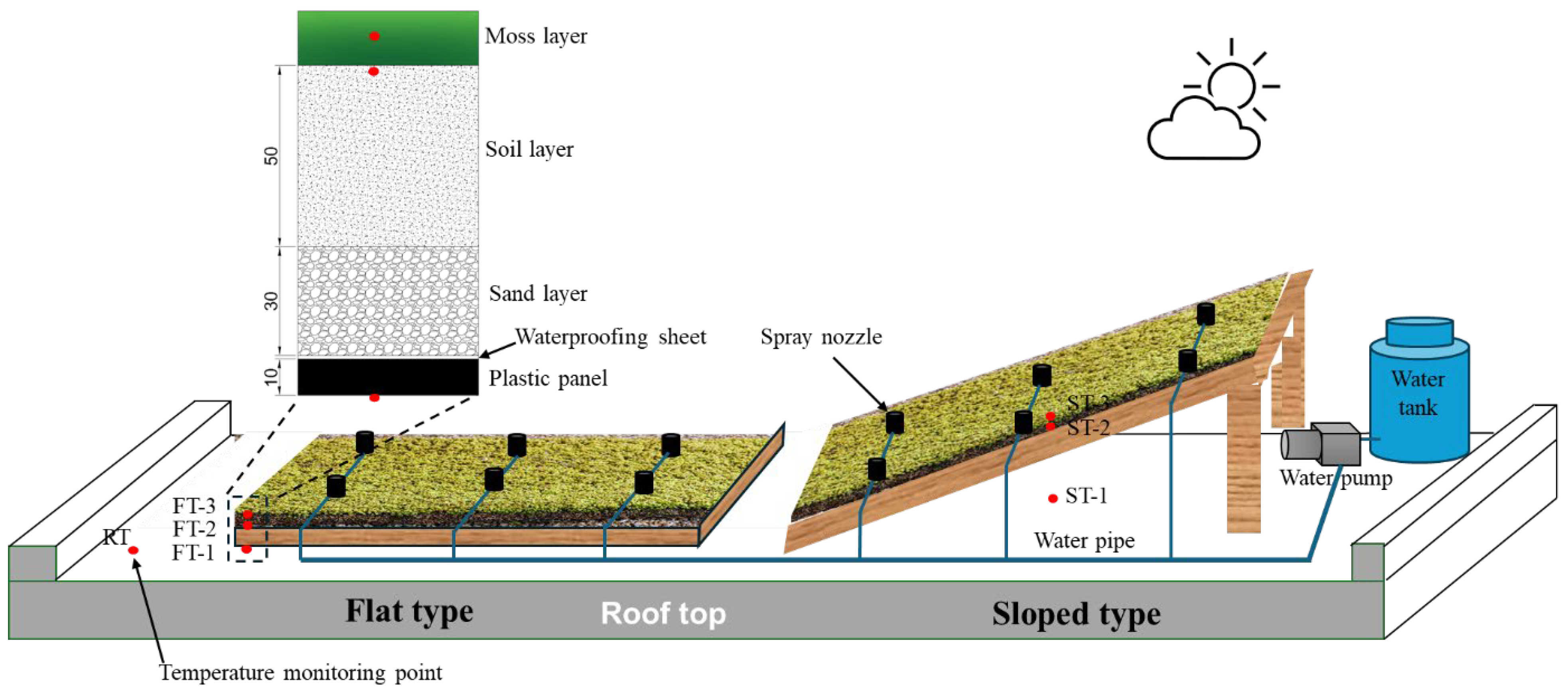
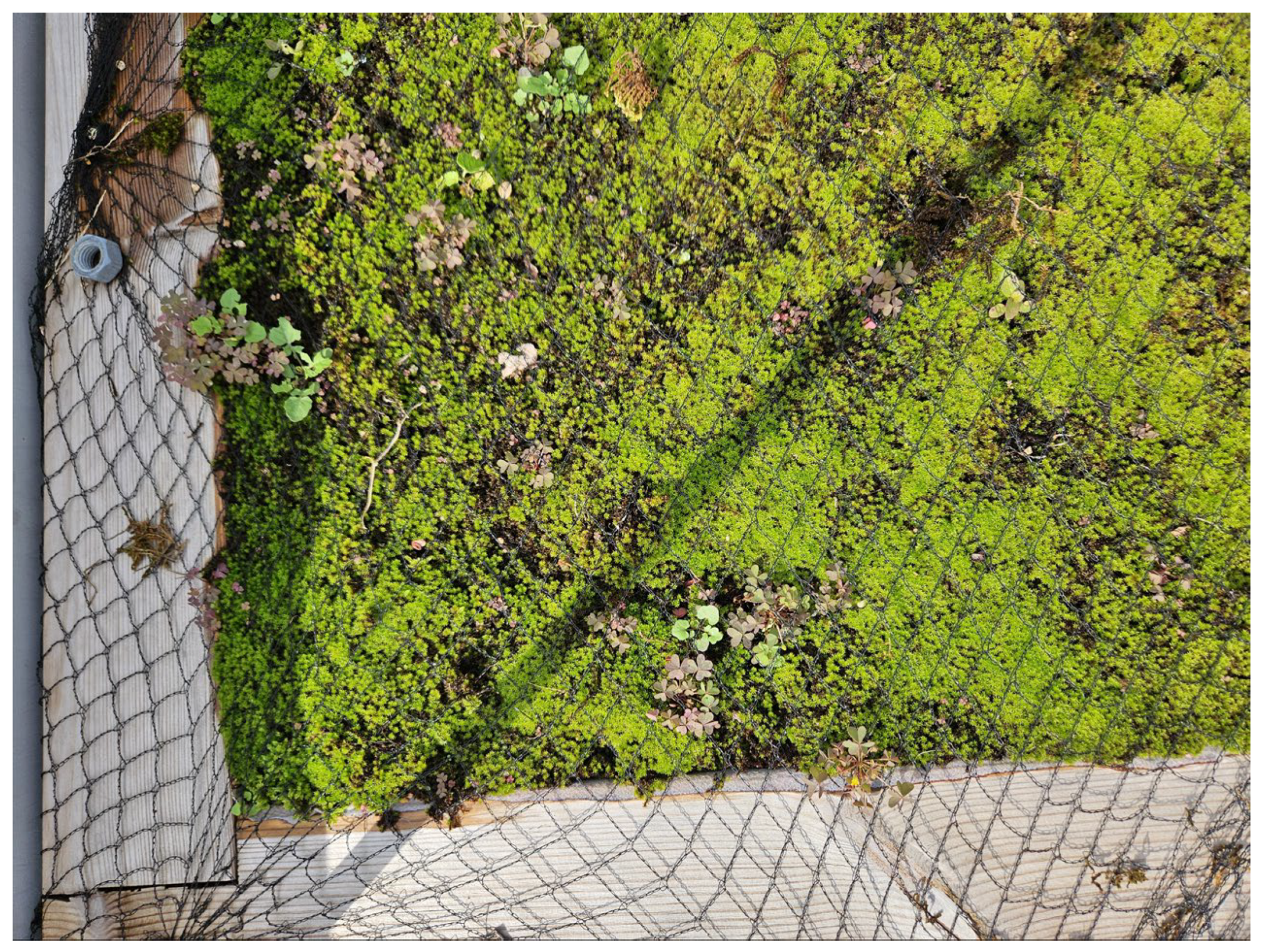




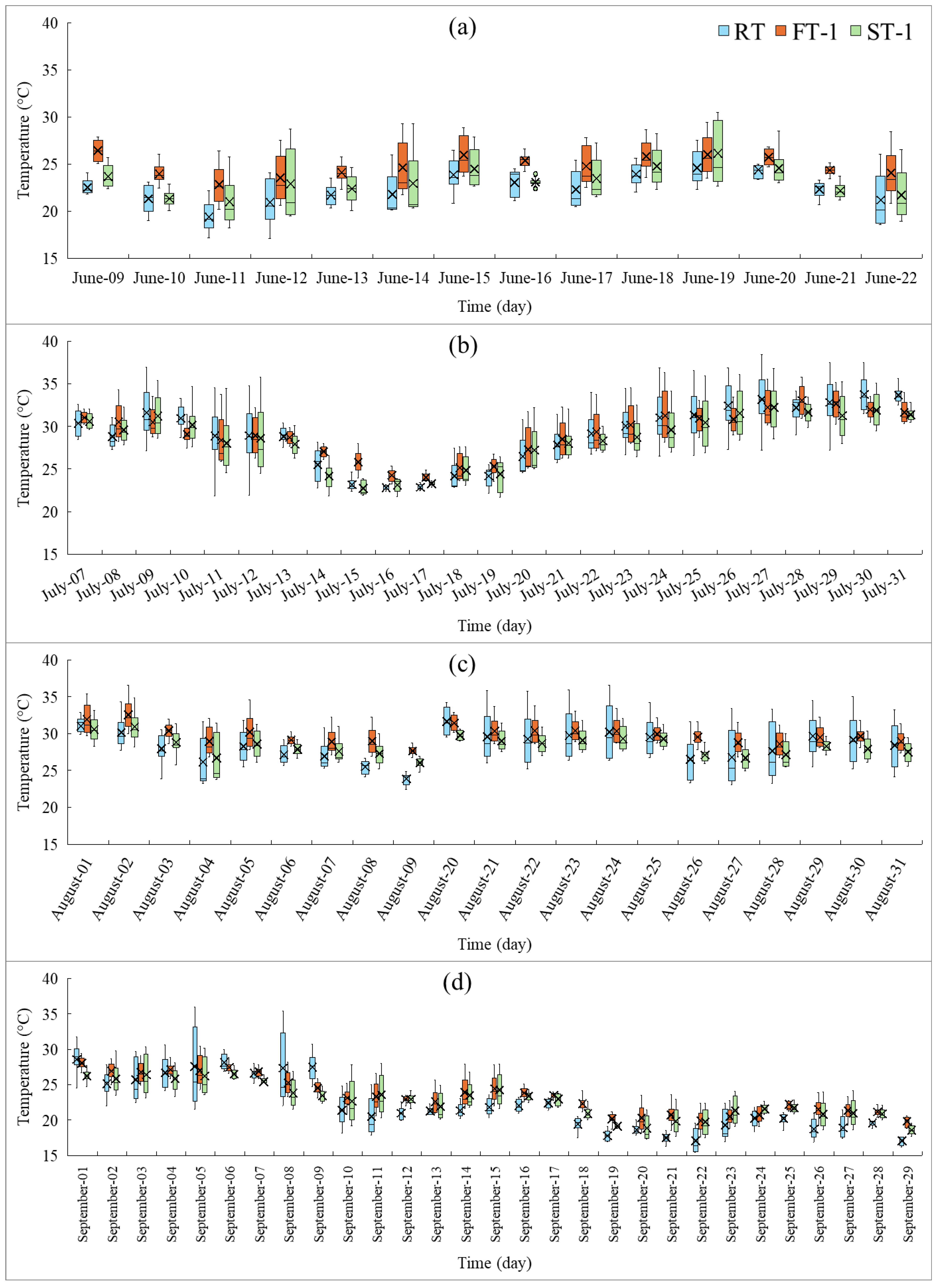

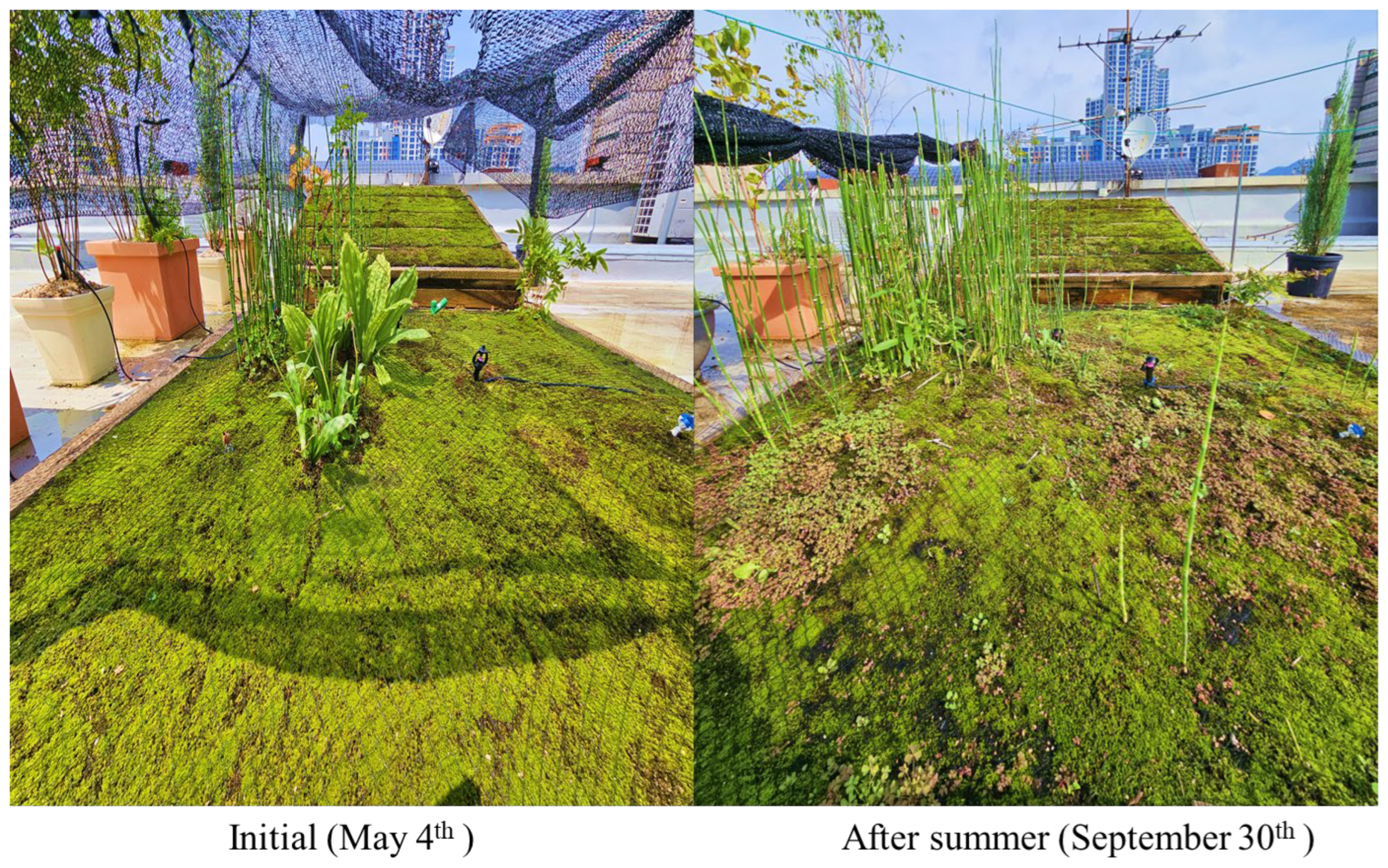
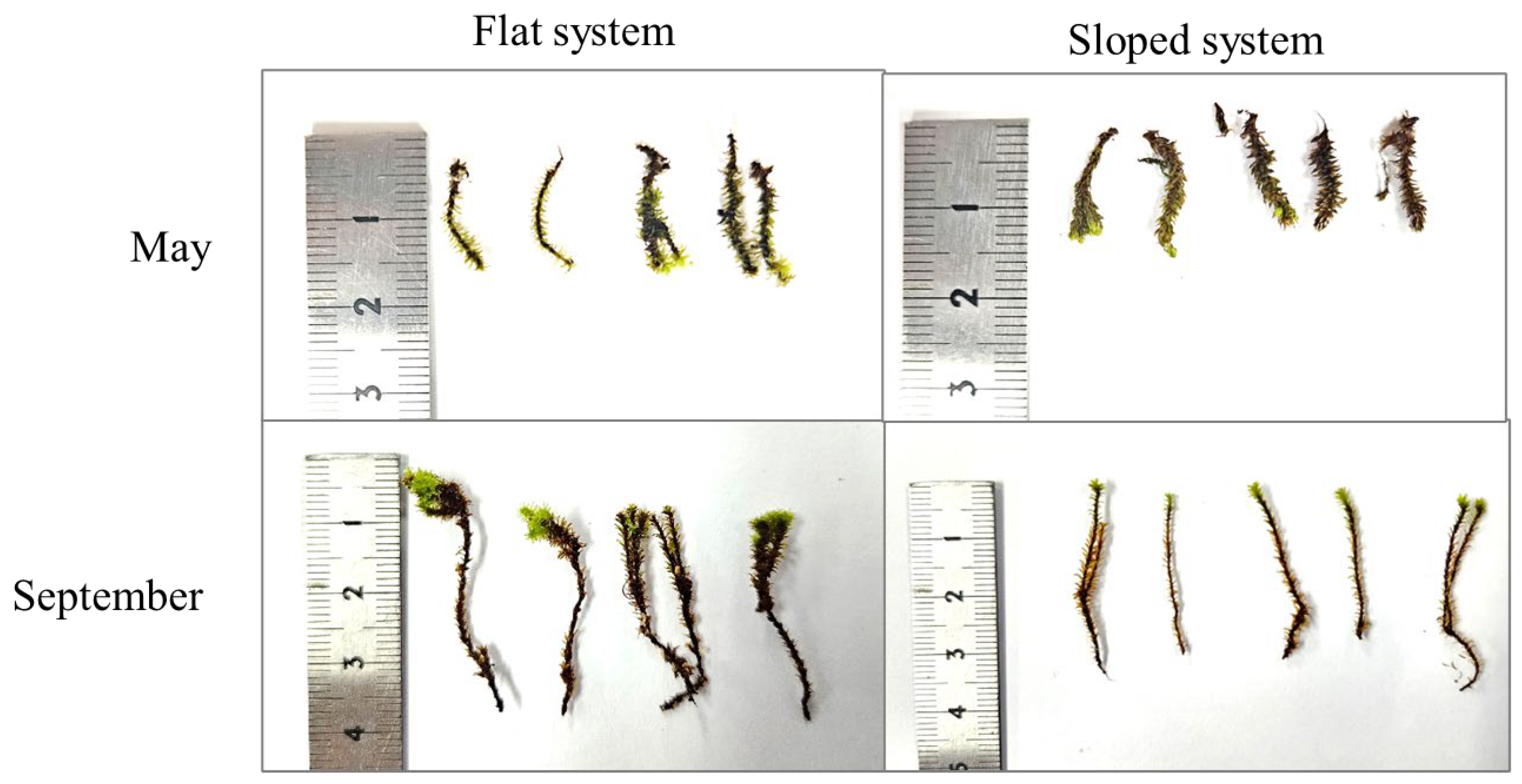


| Moss Species (Focus) | Study Conditions | Objectives | Results (Key Findings) | Location |
|---|---|---|---|---|
| Racomitrium japonicum (Sunagoke), Polytrichum commune, Entodon hians, Didymodon constrictus | Rooftop trials with thin substrates (2–8 cm) | Identify suitable moss species and substrates for low-maintenance roofs | R. japonicum and P. commune showed high survival and cover rates; recommended as primary species for thin, drought-prone roofs | Japan [7] |
| R. japonicum | Full-scale rooftop monitoring at a school | Quantify thermal mitigation | Roof surface temperature reduced by more than 10 °C; canopy further enhanced cooling, which supports use for urban heat mitigation | South Korea [8] |
| Tortella tortuosa, Polytrichum juniperinum (dominant) | Field survey, laboratory pathogen isolation | Identify moss pathogens | Cladosporium spp. confirmed as pathogenic; crucial information for roof maintenance planning | Finland [9] |
| Sedum–moss cover | Roof system (3 cm), hydrology monitoring | Quantify stormwater peak flow reduction | Vegetated roofs delayed runoff; peak flows significantly attenuated despite thin substrate | Sweden [10] |
| Mixed mosses: Brachythecium salebrosum, Bryum argenteum, Ceratodon purpureus, Pohlia nutans, P. juniperinum | Survey of 50 roofs, Helsinki | Identify key factors differentiating sedum–moss and meadow communities | Shallow substrates (<5 cm) favored moss-type roofs; age increases species richness | Finland [11] |
| Sedum–moss roofs | Gut-content metabarcoding of larval samples | Test larval habitat function | Ten moth species were confirmed to feed on sedum; sedum–moss roofs contribute to biodiversity | Belgium [12] |
| Sedum–moss assemblages | Chronosequence study of 31 roofs | Link abiotic variables to plant traits | Deeper substrates favored taller plants with higher SLA, leading to better water retention and cooling potential | Sweden & Finland [13] |
| P. commune, P. piliferum, Atrichum undulatum | Green roof modules (n = 88) in Halifax, Nova Scotia, under drought year conditions | Evaluate moss effects on neighboring vascular plants and roof processes | Mosses reduced substrate temperature, had neutral effect on net water loss, and selectively facilitated Festuca rubra growth. All mosses survived the drought, highlighting their suitability for green roofs. | Canada [5] |
| Dicranoweisia cirrata, Racomitrium canescens, and Antitrichia californica | Laboratory and outdoor rooftop tests at Oregon State University (Corvallis, OR, USA) under a Mediterranean climate, using simulated and natural rainfall events | Evaluate stormwater retention capacity, survival under rooftop exposure, and thermal buffering effects of moss-covered roofs | R. canescens showed the highest water-holding capacity and greatest stormwater retention (~45% in the lab); moss roofs cooled and warmed more rapidly, reducing temperature fluctuations, and survived rooftop exposure with minimal irrigation, making them suitable for lightweight, low-maintenance green roofs | USA [14] |
| No. | Symbol | Measurement Point | Purpose |
|---|---|---|---|
| 1 | RT | Bare roof surface without shadow | To evaluate roof temperature directly influenced by weather |
| 2 | FT-1 | Beneath the flat-type system | To assess the overall temperature mitigation effect of the whole flat system |
| 3 | FT-2 | Within the flat system: inside the soil under the moss layer, 1 cm below the soil surface | To investigate the cooling effect of the moss layer on soil temperature |
| 4 | FT-3 | Within the flat system: inside the moss layer, 5 mm above the soil surface | To investigate the effect of sunlight on moss temperature |
| 5 | ST-1 | Beneath sloped system | To assess the overall temperature mitigation effect of the whole sloped system |
| 6 | ST-2 | Within the sloped system: inside the soil under the moss layer, 1 cm below the soil surface | To evaluate the cooling effect of the moss layer on soil temperature |
| 7 | ST-3 | Within the sloped system: inside the moss layer, 5 mm above the soil surface | To investigate the effect of sunlight on moss temperature |
| Subject | Sensor 1 vs. Sensor 2 | Sensor 1 vs. Sensor 3 | Sensor 1 vs. Sensor 4 | Sensor 1 vs. Sensor 5 | Sensor 1 vs. Sensor 6 | Sensor 1 vs. Sensor 7 |
|---|---|---|---|---|---|---|
| Correlation equation | y = 1.0037x − 0.2074 | y = 0.999x + 0.0664 | y = 0.999x − 0.07 | y = 1.0072x − 0.2616 | y = 0.9991x + 0.0903 | y = 1.0007x − 0.0122 |
| Coefficient of determination | r2 = 0.9882 | r2 = 0.9884 | r2 = 0.9874 | r2 = 0.9889 | r2 = 0.9886 | r2 = 0.988 |
| Time | Parameter | Flat System | Sloped System |
|---|---|---|---|
| Day | RMSE (°C) | 3.24 | 2.01 |
| MNB (%) | −4.25 | −2.64 | |
| t-value | 9.92 | 8.63 | |
| p-value | 3.36 × 10−20 | 3.94 × 10−16 | |
| Effect size | 0.58 | 0.50 | |
| Night | RMSE (°C) | 2.47 | 1.46 |
| MNB (%) | 8.64 | 4.43 | |
| t-value | −40.9 | −28.8 | |
| p-value | 4.56 × 10−123 | 3.90 × 10−87 | |
| Effect size | −2.39 | −1.68 |
| Study Location | Vegetation | Climate Condition | Heat Mitigation Efficiency |
|---|---|---|---|
| Current study (Seoul, South Korea) | Moss | Humid-hot summer | Roof-surface cooling 6–10 °C (daytime); maximum roof-surface cooling: 20 °C |
| Liège, Belgium [38] | Generic grass-type vegetation | Temperate oceanic climate | Maximum roof-surface cooling during heat events: 11–35 °C |
| Melbourne, Australia [39] | Mixed grasses and sedum-type vegetation | Temperate oceanic climate, heatwave event | Surface reduction: 1–3.8 °C |
| Lisbon & Florianópolis, Brazil & Portugal [40] | Sedum | Mediterranean & humid-subtropical | Roof surface cooling: 24–33 °C (max) |
| Cuernavaca, Mexico [41] | Sedum | Semi-warm, sub-humid | Roof-surface cooling: 20.5 °C |
| Catania, Italy [42] | Herbaceous/subshrub plants: Heuchera ‘Obsidian,’ Salvia officinalis ‘Berggarten,’ Stachys byzantine, Sempervivum ‘Reinhard,’ Sedum | Mediterranean climate | Roof-surface cooling (max): -Sedum ~26 °C -Sempervivum ‘Reinhard’ ~25 °C -Heuchera ‘Obsidian’ ~30 °C -Stachys byzantine ~30 °C |
| Carbon Sequestration Rate | Flat System | Sloped System |
|---|---|---|
| Monthly (gC/m2.month) | 25.3 | 27.7 |
| Annual (gC/m2.year) | 303 | 332 |
| No. | Species | Type | Country | Carbon Sequestration (kgC/m2.year) |
|---|---|---|---|---|
| 1 | Newly cultivated strain of R. japonicum Dozy & Molk (this study) | Moss | South Korea | 0.3–0.33 |
| 2 | P. juniperinum [43] | Moss | Alaska | 0.39 |
| 3 | Scorpidium scorpioides and Drepanocladus trifarius [44] | Moss | Greenland | 0.001 |
| 4 | Hylocomium splendens [45] | Moss | Italia | 0.07–0.17 |
| 5 | Scots pine tree [46] | Pine tree | Hyytiälä forest, Finland | 0.2 |
| 6 | Fagus sylvatica [46] | Beech trees | Soro forest, Denmark | 0.2 |
| 7 | Canadian forests [47] | Pine trees | Canada | 0.1–0.63 |
Disclaimer/Publisher’s Note: The statements, opinions and data contained in all publications are solely those of the individual author(s) and contributor(s) and not of MDPI and/or the editor(s). MDPI and/or the editor(s) disclaim responsibility for any injury to people or property resulting from any ideas, methods, instructions or products referred to in the content. |
© 2025 by the authors. Licensee MDPI, Basel, Switzerland. This article is an open access article distributed under the terms and conditions of the Creative Commons Attribution (CC BY) license (https://creativecommons.org/licenses/by/4.0/).
Share and Cite
Kim, S.; Dinh, T.-V.; Park, B.-G.; Lee, S.-W.; Jung, K.; Chung, H.; Kim, J.-C. A Study on a New Moss for Moss-Based Green Roofs in Roof Surface Temperature Mitigation and Carbon Capture. Atmosphere 2025, 16, 1277. https://doi.org/10.3390/atmos16111277
Kim S, Dinh T-V, Park B-G, Lee S-W, Jung K, Chung H, Kim J-C. A Study on a New Moss for Moss-Based Green Roofs in Roof Surface Temperature Mitigation and Carbon Capture. Atmosphere. 2025; 16(11):1277. https://doi.org/10.3390/atmos16111277
Chicago/Turabian StyleKim, Seungjae, Trieu-Vuong Dinh, Byeong-Gyu Park, Sang-Woo Lee, Kweon Jung, Haegeun Chung, and Jo-Chun Kim. 2025. "A Study on a New Moss for Moss-Based Green Roofs in Roof Surface Temperature Mitigation and Carbon Capture" Atmosphere 16, no. 11: 1277. https://doi.org/10.3390/atmos16111277
APA StyleKim, S., Dinh, T.-V., Park, B.-G., Lee, S.-W., Jung, K., Chung, H., & Kim, J.-C. (2025). A Study on a New Moss for Moss-Based Green Roofs in Roof Surface Temperature Mitigation and Carbon Capture. Atmosphere, 16(11), 1277. https://doi.org/10.3390/atmos16111277








